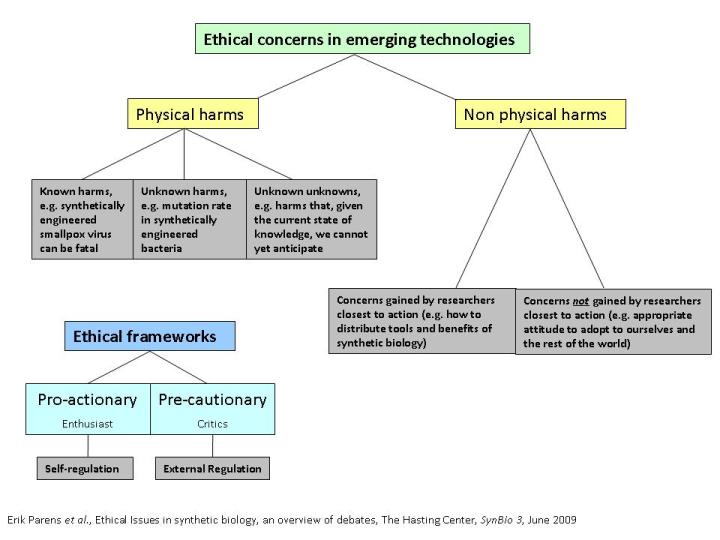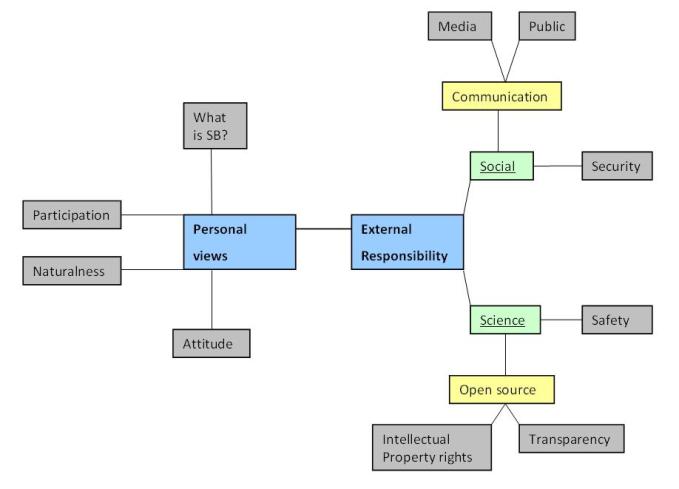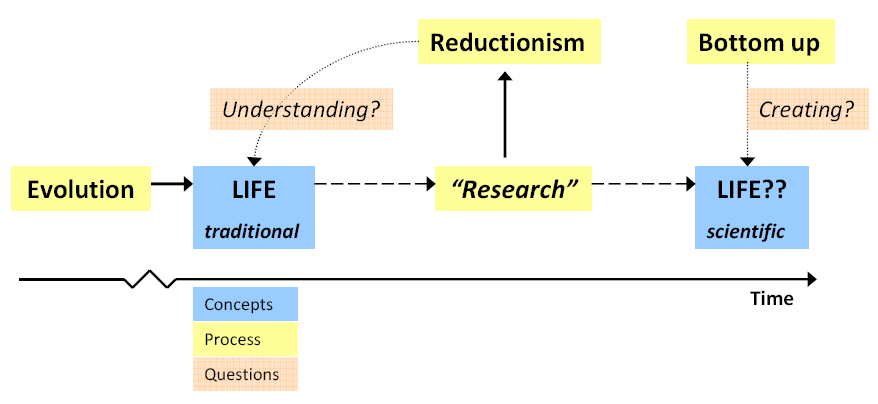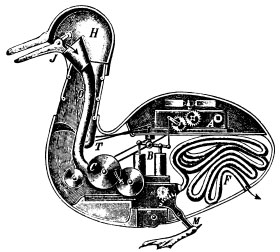Team:TUDelft/Ethics background
From 2009.igem.org
(→Frameworks) |
(→Ethical issues in synthetic biology) |
||
| Line 61: | Line 61: | ||
<br><br> | <br><br> | ||
<FONT SIZE="-2"> | <FONT SIZE="-2"> | ||
| - | '''References''': [http://www.is-journal.org/V02I01/2ISJLP053.pdf Gorman, 2006] | [http://www.thenewatlantis.com/publications/the-promise-and-perils-of-synthetic-biology Tucker, 2006] | [http://www.synbioproject.org/library/publications/archive/synbio3/ Parens, | + | '''References''': [http://www.is-journal.org/V02I01/2ISJLP053.pdf Gorman, 2006] | [http://www.thenewatlantis.com/publications/the-promise-and-perils-of-synthetic-biology Tucker, 2006] | [http://www.synbioproject.org/library/publications/archive/synbio3/ Parens, 2009] | [http://www.nature.com/nature/journal/v438/n7067/full/438423a.html Church, 2005] | [http://www.nature.com/embor/journal/v10/n1/full/embor2008232.html Samuel, 2009] | [http://www.bbsrc.ac.uk/organisation/policies/reviews/scientific_areas/0806_synthetic_biology.pdf Balmer, 2008] | [http://www.mtzstiftung.de/sites/mtzstiftung.de/myzms/content/e162/e356/e1417/e1988/nbt0408-387.pdf Boldt, 2008] | [http://www.nature.com/nbt/journal/v27/n4/full/nbt0409-321.html Mitra, 2009] |
<br> | <br> | ||
</FONT> | </FONT> | ||
Latest revision as of 15:05, 21 December 2009
Ethical issues in synthetic biology
An introduction to the main ethical issues in synthetic biology and an explanation of why reductionism in biology raises ethical concerns.
Introduction
The marriage between technologies in molecular and cellular biology together with genetic and chemical engineering gave life to a new phenomenon called synthetic biology. Since then, a lot of ethical questions were raised. Although the definition of synthetic biology is not yet clear and future implications are yet uncertain, research in the field of synthetic biology is at its peak. Different articles claim that synthetic biology is the answer to curing cancer and the production of bio-fuel, and several leading universities assembled specific departments for this field of research. An OpenWetware created by the Massachusetts Institute for Technology, gives free access to a large registry of BioBricks: basic “ready to use” biological machinery components. The most important resource for these BioBricks comes from the annual iGEM (international genetically engineered machine) competition, in which teams of students can compete on building the best microorganism machine by combining, describing, implementing and/or designing these biological standardized parts.
References: [http://www.nature.com/nature/journal/v438/n7067/full/438423a.html Church, 2005] | [http://www.partsregistry.org/Main_Page Parts Registry] | [http://www.sciencemag.org/cgi/content/abstract/315/5813/801 Stephanopoulos, 2007]
Definition
Although the term has been abundantly used for almost a decade, there is no consensus on a definition for synthetic biology. Different practical approaches to synthetic biology research and engineering emanate from different disciplines, resulting in an intangible characterization. An attempt by the European Commission to describe synthetic biology resulted in partial acknowledgement by the scientific community. The EC tried to reflect how synthetic biology differs from other emerging technologies and focused on constructing of artificial life forms with use of engineering principles applicable in biology. Their working definition of synthetic biology is as follows:
“Synthetic Biology is the engineering of biological components and systems that do not exist in nature and the re-engineering of existing biological elements; it is determined on the intentional design of artificial biological systems, rather than on the understanding of natural biology” (EC, 2005).
References: [http://www.bbsrc.ac.uk/organisation/policies/reviews/scientific_areas/0806_synthetic_biology.pdf Balmer, 2008] | EC, 2005 |
Frameworks
There is a lot of literature on ethical issues in synthetic biology. A road map to illustrate the main concerns is shown in Figure 1. This road map (based on a paper of [http://www.synbioproject.org/library/publications/archive/synbio3/.com Parens, 2009]) is generally applicable for emerging technologies, but is currently designed to focus on synthetic biology. The ethical concerns that are mainly addressed in literature are "physical harms" and concerns gained by researchers "closest to action" in synthetic biology. The first concerns on bio-safety and bio-security, where the latter involves matters such as intellectual property rights and transparency.
Unfortunately the scientific community lacks an appropriate attitude towards themselves and the rest of the world. An under valuated but nevertheless important subject in synthetic biology is the fact that we might change the perception of life when we try to (re)engineer life or even try to create it from scratch (Craig Venter's [http://www.pnas.org/content/103/2/425.abstract minimal genome project]). The reductionist approach (a method of understanding complex systems by analyzing the subsystems that it is composed of) has brought a lot of benefits in understanding physics and chemistry, and has definitely helped in understanding biological systems. But now we have come to the point that we are designing living systems. Some even believe we are at the brink of defining and even creating life. The concerns and consequences of this progression should be described and discussed elaborately.
Parens et al. also describes a framework that distinguishes two groups responding differently to questions concerning physical harms. The pro-actionary people think more of the benefits of the research than its possible implications. The pre-cautionary community is concerned about safety and security instead of rather thinking about the opportunities. As it comes to regulation and policies, the enthusiasts would keep the authority to themselves, whereas the critics would rather see external regulation on safety and security issues.
References: [http://www.nature.com/nature/journal/v420/n6914/full/420350b.html Check, 2002] | [http://www.synbioproject.org/library/publications/archive/synbio3/ Parens, 2009]
Concerns
The concerns in synthetic biology that typically appear in literature include bio-safety, bio-security, transparency and intellectual property rights. Topics concerning the attitude towards life, reductionism and public involvement that are relatively hard to address but nonetheless important, do not obtain the attention they deserve. A list of the ethical concerns:
- Bio-safety (Regulations for working in synthetic biology)
- Bio-security (Consequences of synthetic biology, e.g. bio-terrorism)
- Intellectual property rights (conflict of interest, fair distribution of benefits and who owns what?)
- Transparency (open source, availability)
- Communication (towards public and media)
- Naturalness (or artificialness)
- Attitude (towards life)
- Reductionism (consequences and implications when reducing biological systems)
Since the introduction of synthetic biology, ethical issues have been addressed and different opinions, frameworks and solutions have been proposed. To get an overview of opinions and responsibilities relevant to different topics, we propose a framework that describes the main ethical considerations from a personal perspective, as shown in Figure 2.
The personal view describes features on how we perceive synthetic biology, what is our attitude towards life, and why do we participate in such research. The believes, perceptions and reasons for people to understand and work in the field of biology will vary between individuals. When involved in synthetic biology research, it is worthy to study these different subjects, both to improve evaluation of the research and to self-reflect on a scientific and personal level. Moreover, when working together in a team it is important to know that team members can have different opinions. A healthy discussion can help the research because you can respect each others differences and learn of other viewpoints. Furthermore, it shows peoples personal qualities.
Externally, researchers are responsible on a social level for communication and security of the public. On a scientific level they should concern the safety of themselves and co-workers. In synthetic biology specifically they have to think about the consequences of making biological components freely available, how to deal with intellectual property rights and to what extend the research should be transparent to the community.
References: [http://www.is-journal.org/V02I01/2ISJLP053.pdf Gorman, 2006] | [http://www.thenewatlantis.com/publications/the-promise-and-perils-of-synthetic-biology Tucker, 2006] | [http://www.synbioproject.org/library/publications/archive/synbio3/ Parens, 2009] | [http://www.nature.com/nature/journal/v438/n7067/full/438423a.html Church, 2005] | [http://www.nature.com/embor/journal/v10/n1/full/embor2008232.html Samuel, 2009] | [http://www.bbsrc.ac.uk/organisation/policies/reviews/scientific_areas/0806_synthetic_biology.pdf Balmer, 2008] | [http://www.mtzstiftung.de/sites/mtzstiftung.de/myzms/content/e162/e356/e1417/e1988/nbt0408-387.pdf Boldt, 2008] | [http://www.nature.com/nbt/journal/v27/n4/full/nbt0409-321.html Mitra, 2009]
Responsibility
The proposed framework can function as a guideline for what is important and what are our responsibilities when working on synthetic biology. Although most of the topics are addressed in literature, policymakers are lagging behind in making regulations concerning these topics. Specifically a lot of questions are raised concerning bio-safety and bio-security. For example, what are the possibilities or chances of bio terrorist using synthetic biology for harmful purposes or what are the consequences of do-it-yourself synthetic biology, when people can engineer organisms in their own backyard. Regulations and policies should clarify these uncertainties. But the problem is: who is responsible? Should the government create certain guidelines, or should the scientific community self-regulate their own research? Are existing guidelines and safety measures on genetic engineering enough, or do we need to extend this? What about the open source properties, what if somebody patents a gene? Another question that follows from this discussion is whether synthetic biology is as new as some papers make us believe. Do we really need new guidelines? Did we not already describe safety regulations to keep modified organisms in the laboratories?
These are difficult questions, certainly because key stakeholders will have different opinions and demands (e.g. see Figure 1, critics and enthusiasts). Although these questions have an ethical undertone, they are better categorized in the policy and regulatory field. The ethical aspects have been described extensively. It is now up to the policymakers to identify the problems, see where guidelines are needed and implement clear regulations when necessary.
References: [http://www.bbsrc.ac.uk/organisation/policies/reviews/scientific_areas/0806_synthetic_biology.pdf Balmer, 2008]
Reductionism
As has been stated by Arthur Caplan (Director of the Center for Bioethics at the University of Pennsylvania) during his speech at the Woodrow Wilson Center for Scholars, [http://www.wilsoncenter.org/index.cfm?topic_id=166192&fuseaction=topics.event_summary&event_id=492968 Synthetic biology: is ethics a showstopper?], the key ethical issues in synthetic biology are reductionism (when life is reduced to genetics) and playing God (the bottom-up approach of creating living systems). Issues concerning safety, security and handling of intellectual property rights should be related to politics not ethics. Although these topics need good regulation, ethics does not play a great role there. Instead, bio-ethicists should focus on questions concerning life, specifically the reductionist (top-down) approach towards understanding life, and the bottom-up approach to create life.
The reductionist approach in general, is a method to understand complex systems by understanding its subsystems. So essentially, you break down a system into smaller components and try to explain how the system works by evaluating the components. This theory is depicted graphically in Figure 3. Although this method has been used abundantly in science to describe phenomena that occur in nature successfully, in some cases it is still limited. The main reason for this limitation is the occurrence of emerging properties that cannot be described by only looking at the components of system.
In synthetic biology and in science overall, the top-down approach has been applied to identify how a system works as it does. In physics, one might calculate the velocity of a falling ball by taking into account the gravitational force, and the friction between medium and the ball as separate components. In biology, to understand living systems we can reduce the complexity by for e.g. focusing on specific organs (for higher eukaryotes) or go even further down to the cellular level. In synthetic biology, we look at the molecular level to see how organisms work. One of the major breakthroughs in the past century is the elucidation of the DNA structure by Watson and Crick. They set the path for discovering what is now believed to be the foundation of life, the omnipresent translational system based on a 4 letter code inscribed in the DNA double-helix, accounting for metabolism and reproduction of living systems. Synthetic biology plays a key role in clarifying the complex principles of the translational system and enlighten the enigmatic foundation of life on a molecular level.
What happens if the reductionism approach will eventually show us what life is all about? What happens when humans can create living systems? We cannot foresee if research in synthetic biology will be able to reach those goals. But since the scientific community is getting closer en closer to the foundation of living systems, the ethical questions become much more important. To get an overview of what plays a role in evaluating reductionism in synthetic biology, we propose a framework in which we display the connection between evolution, life, and reductionism.
Since Darwin's work On the Origin of Species in 1859, a lot of scientific theories suggest that the world as we know it is a product of millions of years of evolution. This phenomena that mankind will probably never be able to fully understand has produced a complex biological world with an entangled network of many different living systems and (non)organic materials. Science indicates that only a relatively short period of time the homo sapiens have walked the earth (surprisingly on two legs) and have evolved to a sophisticated heterogeneous community with thoughts, believes, opinions, consciousness, and the ability to adapt and improve survival chances better then any other organism. The property that made mankind the top of the food chain is its ability to use the brain efficiently. One of the things that humans have used their brain for, is to give definitions to the things that they saw and heard. So what about LIFE? Society has come to a point where it wants to make a distinction between living systems (with the potential to expire) and non-living systems. But the problem is to make a clear cut between these two. The scientific community has come up with some properties that are specific for living systems, such as the ability to reproduce, evolve and metabolize. Although these properties are quite clear, it is also suggested that this list is insufficient. We still don't know for certain what constitutes life. Moreover, scientists tend to look at living systems with a biochemical approach. But what if biological systems are fundamentally special in some way? Is there more to life than we can imagine? Is there a higher power? Is life holy or sacred? We just don't know. However, it is definitely important to distinguish how life is perceived by the general public and what is believed and proven in science.

How people perceive information of any kind differs between individuals. External influences play a great role and cultural differences have a big hand in the process of believing and perceiving. Additionally, what we perceive to be true might not be the reality. This concept is beautifully depicted in Margritte's painting, which makes people realize they are not looking at a pipe, but at a painting, which is flat and contains paint applied on canvas.
Synthetic biology is a key player in the search for answers regarding life. The reductionism approach that has proven itself to be very useful in physics and chemistry is now applied in biology to get to know the foundation of life. Fundamental research on the molecular level has given us indication that DNA is the basis of all life forms and genetic engineering has given researchers the ability to change this genetic code. But is that all? Or is there more to it? Should we go on with chasing answers for these typical questions? What happens if we find out?
One of the results of the top-down approach towards understanding living systems is that we can now understand how certain substructures of complex living systems work, and sometimes even how they interact with other substructures. But there is still a very long road (if not endless) to completely understanding the complicated superstructure called life. A different result is that understanding substructures of living entities proceeded in creating these substructures artificially. It did not take long before they were implemented in simple organisms and were proven to function there, in some cases even more efficiently than the original "natural" system.
The Digesting Duck, an automaton created by Jacques de Vaucanson in 1739 is an example of the principles of Descartes' mechanistic universe, which argues that we can begin to understand complex things by studying the most fundamental aspects of them - a concept known as reductionism. The duck appeared to have the ability to eat kernels of grain, and digest them. While the duck did not actually have the ability to do this - the food was stored in a container, and pre-stored feces was "produced" after minutes - Vaucanson hoped that a truly digesting automaton could one day be build.
The bottom-up approach of enhancing organisms has been going on since genetic engineering was applied first in 1973, although mankind has been altering live since they were able to manipulate crop growth and directed the reproduction of animals. What they did not know then was that they were manipulating DNA of descendant live forms, and thereby enhancing evolution for their own good. So what is different now? Are the attempts to manipulate DNA directly and implement it in an organism one step too far? Or is it nothing different from genetic engineering as researchers have been doing since the 70s? Research proposed by Craig Venter and others indicate that we are about to open the door to understanding what life is all about, and that synthetic biology is the key. Why does this next step scare some people? Are we afraid of the possible results? Do we care too much about our present perception of life? Scared of possible disappointed? But then again, should we be anxious? Maybe understanding the principles of life could give life more value. Moreover, it could well be that the reductionism approach is limiting in defining life. Maybe life has this property that does not let it explain in chemical and physical principles. Whether or not this might be true, getting to this point in evolution makes us morally obliged to think about such questions.
References: [http://www.nature.com/nature/journal/v421/n6919/full/421118a.html Benner, 2003] | [http://www.plosbiology.org/article/info:doi/10.1371/journal.pbio.0060095 Caplan, 2008] | [http://science-mag.aaas.org/cgi/content/summary/286/5447/2087 Cho, 1999] | [http://findarticles.com/p/articles/mi_m1374/is_3_60/ai_62111884/ Clark, 2000] | [http://camtriplehelix.com/magazine/synthetic7.pdf Pace, 2009] | [http://www.nature.com/nbt/journal/v15/n13/abs/nbt1297-1322.html Short, 1997] | [http://www.pubmedcentral.nih.gov/articlerender.fcgi?artid=1299179 Regenmortel, 2004] | [http://www.rsc.org/delivery/_ArticleLinking/ArticleLinking.asp?JournalCode=MB&Year=2009&ManuscriptID=b901484e&Iss=7 Agapakis, 2009] | [http://www.uchicago.edu/research/jnl-crit-inq/issues/v29/v29n4.riskin.html Riskin, 2003] |
[http://www.thehastingscenter.org/Publications/BriefingBook/Default.aspx The hasting centre, 2008] | [http://journals.cambridge.org/action/displayAbstract?fromPage=online&aid=2872712 Calvert, 2008] | [http://genomebiology.com/content/2/2/COMMENT2002.1 Peterson, 2001] | [http://www.nature.com/nature/journal/v420/n6914/full/420350b.html Check, 2002] | [http://www.scribd.com/doc/24588/Zen-and-the-Art-of-Creating-Life Ray, 1993] | [http://www.independent.co.uk/news/science/playing-god-the-man-who-would-create-artificial-life-773859.html Conner, 2008] | [http://dsc.discovery.com/technology/my-take/synthetic-biology-caplan.html Caplan, 2009]
 "
"












